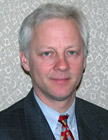Advances in radiation therapy for cancer have made it possible to fine-tune radiation beams so they match the shape and position of a patient’s tumor nearly anywhere in the body. But tumors that move, such as those in the lung — which can change position during each breath — are a special problem for radiation oncologists.
A School of Medicine group has studied the way lung tissues move during breathing in hopes of improving radiation as a treatment for lung cancer.

While surgical removal of a malignant tumor is the preferred way to treat lung cancer, surgery may not be feasible if medical conditions make the operation very risky or if the tumor has grown into structures that cannot be removed.
In such cases, as long as the cancer has not metastasized, radiation therapy offers a real chance for cure. Studies show that 3-D techniques that deliver high doses of radiation in the precise shape of the tumor are more effective than older techniques.
“Ideally, the radiation should be delivered to as small an area as possible so normal tissue near the tumor isn’t damaged,” said Daniel Low, Ph.D., professor of radiation oncology and director of the Medical Physics Division. “But with a lung tumor, you need to irradiate a larger area if you want to encompass the tumor as it moves. One option to avoid this is to just turn on the radiation beams during a certain phase of the breathing cycle, but that assumes that patients breathe regularly and the tumor returns to the same place with each breath.”
On the contrary, Low and his colleagues have found that people’s breathing can be quite chaotic, so they have developed mathematical descriptions of the motions of different parts of the lung as people breathe.
Low said that people change the speed of their inhalation and exhalation as well as the volume of their breath.
“Sometimes you just reduce the amount of air in your lungs a little,” he said. “You breathe a little shallower, and the diaphragm pulls upward a little. I would never have guessed this subtle drift in the breathing cycle would create a significant error for radiation dosage, but it does.”
Low and his colleagues have developed an apparatus called the 4D Phantom, a machine that can move in the complex patterns specified by the researchers’ mathematical model of breathing motion. The 4D Phantom contains an object, or phantom, that represents a tumor and allows researchers to test any part of the radiation therapy process from imaging to treatment.
Whereas other such systems are limited to ellipsoidal or other simple preset motion paths, the 4D Phantom is capable of moving a radiological phantom through custom trajectories specified at 50 positions per second. Thus, it can reproduce real tissue motion.
The research group’s investigation of breathing motion has revealed that parts of the lung move a lot while others stay more stationary and that some parts move quickly while others move slowly. Based on their ever-expanding base of information, they are attempting to build more sophistication into the movement of their 4D Phantom.
“Parag Parikh [M.D., instructor in radiation oncology] designed the software for the first dynamic phantom,” Low said. “Now, he is working with a team of engineering undergraduate students to create an even more lung-like phantom that moves in a patient-realistic pattern.”
These advances can help improve radiation treatment plans because they can be used to check the accuracy of equipment and computer software used to obtain 4-D computed tomography (4D CT) scans. 4D CT allows physicians to locate tumors and create a 3-D model of a patient’s internal organs that accounts for bodily movement during the time course of the scan.
The 3-D model, in turn, guides treatment modalities such as intensity-modulated radiation therapy in which several radiation beams are turned on and off and their intensity altered depending on the organs that the beams pass through.
Low said one of the most important consequences of their research is a new understanding of how mobile lung tumors are.
“What we are finding by looking at this problem in a very concentrated way is that the position of a tumor changes every day in the chest cavity,” Low said. “These things can have a profound effect on the quality of radiation therapy unless we can take into account how they affect tumor position.”